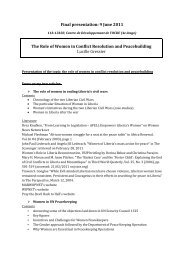Women's Economic Opportunity Index - Economist Intelligence Unit
Women's Economic Opportunity Index - Economist Intelligence Unit
Women's Economic Opportunity Index - Economist Intelligence Unit
- No tags were found...
Create successful ePaper yourself
Turn your PDF publications into a flip-book with our unique Google optimized e-Paper software.
Appendix IWomen’s economic opportunityA new global index and rankingSocial Politics, Vol. 10 (Spring), 2003, pages 49-85.J Waldfogel, “The Family Gap for Young Women in the <strong>Unit</strong>ed States and Britain: Can Maternity LeaveMake a Difference?”, Journal of Labour <strong>Economic</strong>s, Vol. 16, No. 3 (July), 1998, pages 505-545.C R Winegarden and P M Bracy, “Demographic consequences of maternal leave programs in industrialcountries: evidence from fixed-effects models”, Southern <strong>Economic</strong> Journal, Vol. 61, No. 4 (April), 1995,pages 1020-1035.M Ronsen and M Sundstrom, “Family Policy and After-Birth Employment Among New Mothers - AComparison of Finland, Norway and Sweden”, European Journal of Population Vol. 18 (June), 2002, pages121-152.Restrictions on Job Types22. Rio Tinto presentation,March 9th 2010 at the UNDevelopment Fund for Women,Women’s EmpowermentPrinciples launch. Notesavailable at http://www.riotinto.com/documents/Media-Speeches/Why_gender_matters_9_March_2010.PDF.Mongolia 1999 Labour Code(Sec. 104). Source: Women,Business and the Law database.http://wbl.worldbank.org.23. V Forastieri, “InformationNote on Women Workersand Gender Issues onOccupational Safety andHealth”, International LabourOrganisation: Geneva, 2000.24. Report of the 11th Session ofthe Joint International LabourOrganisation/World HealthOrganisation Committee onOccupational Health (Geneva,April 27th-29th 1992), Ref:JCOH/XI/92.25. “Gender and Development inthe Middle East and North Africa:Women in the Public Sphere”,MENA Development Report, WorldBank: Washington DC, 2004.26. I Titova, “Female studentdenied right to drive metrotrains”, St. Petersburg Times,March 10th 2009.A Bronstein, “The new labourlaw of the Russian Federation”,International LabourOrganisation InternationalLabour Review, Vol. 144, No. 3,2005, pages 291-318.More than half the countries included in the <strong>Index</strong> have at least one legal restriction on the types of jobsfor which women can be employed. Some of these restrictions were initially established with good intent,in most cases to protect women from so-called hazardous jobs. Out of a sense of concern for workingwomen, many countries adopted special measures that included prohibition of night work, undergroundwork and other activities considered dangerous to women and their reproductive health, includingexposure to certain agents. Other measures limited the weekly number of hours of work and overtimework, and were intended to protect women’s roles as mothers and wives.However, international labour policy is increasingly recognising that any type of employment restrictionon women limits their opportunities. For example, women in Mongolia are prohibited from workingunderground, which reduces the types of employment that they can obtain at Rio Tinto’s gold and coppermining project in southern Mongolia. 22 Instead of reducing the workplace risk for all workers, women as agroup have been excluded from hazardous occupations. An example of this approach is the prohibition ofwomen from working with lead at the beginning of the twentieth century. Although there is no significantdifference in the toxicological response between sexes, women were more exposed because of the type ofwork they undertook. With this measure, women were excluded and men remained unprotected. 23The 11th session of the Committee on Occupational Health of the ILO and the World HealthOrganisation (WHO), in 1992, recognised that there are specific occupational risks based on factors suchas gender and age, and encouraged addressing these issues in such a way so as to not lead to further,inadvertent discrimination. 24Where there is no scientific evidence that certain jobs have a direct, negative impact on women’s healthand safety, job restrictions pose a constraint on women’s employment opportunities. For example, womenin Morocco cannot hold posts in certain ministries (the Ministries of Interior, Civil Protection, NationalDefence, and National Security), 25 and in Russia women are not allowed to drive a metro train, but can bean announcer (the Russian labour code lists about 460 jobs that women cannot hold). 26Further ReadingAdriana Eftimie, Katherine Heller and John Strongman, “Gender Dimensions of the Extractive Industries:Mining for Equity” (Extractive Industries and Development Series #8), August 2009, World Bank:Washington DC, 2009.107 <strong>Economist</strong> <strong>Intelligence</strong> <strong>Unit</strong> 2010




